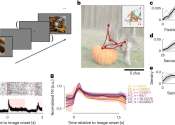Macaque study sheds light on brain's perception of static images
We may not realize it, but our eyes constantly make rapid movements—two to three per second—even when we're looking at the same spot. Yet despite these frequent eye movements, we still perceive what we see as a stable ...
Apr 29, 2024
0
40



